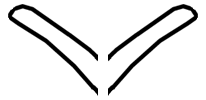| Table of Contents
|
The pattern. Now that you have the pattern pieces and know what they will look like you can begin to create your own. Please note that this method is not documented in period that I can find yet. The instructions are derived from Le Gant, this book speculates on how the pieces were achieved. Most of the books that I have read that have been written in the 20th century by Americans also conclude the same method was used. To the best of my knowledge this is the process to go by.
1. Take paper and place your hand at the edge of it with your thumb hanging off slightly. Not too much as you want to make marks where your thumb attaches to the hand. Leave your fingers slightly open and trace the hand creating as close to parallel lines as possible. Beginning with the pinky, move it enough to make a point with your pencil between the fingers where they meet at the trunk of the hand. Do this for each finger. At the first line mark the end with an A. Make dots B and C where you thumb comes out of your hand. Make lines from the top of the webbing of the thumb and the bottom of the thumb perpendicular to the edge of the pattern to just under point A.
The finished product will look like this:

2. Take the same page and place it at an angle between each finger set to follow the fold of the skin between them.

Carefully trace each finger as you go. Each one will look like this:

3. When you are done match up the fingers. Forefinger with middle finger, middle finger with the ring finger, and ring finger with the pinky, you will end up with three fourchettes. They will look like this:

4. The thumb. There are more ways to make this piece than you have fingers and toes. Chose your type based on the gloves of the period you wish to emulate. They will vary by country, century, and crown. Here is the simplest one that I have found to get you started and then when you are comfortable you may vary as far as you wish.
First create the location where it will be fitted into. Mark on your trank pattern where the lines you made earlier to the marks you made from the side to center between the fore and middle fingers, (see illustration of the hand in the first part of this article). Draw a circle using the marks you made before as your measure for the diameter. At the top center of the circle draw a dip that is the depth of the angle of the fold of your thumb.
Still with me? Every pattern for gloves that I have found either gives you the thumb piece or tells you to put on the glove with only the sides pinned in place and drape a piece of fabric on it.
Next you will go back to your tracing paper and trace the profile of your thumb. Start at the top of the inside webbing of where the thumb connects to the hand, up to the top of the thumb and down to the bottom of the thumb at the base of the hand. Draw a mirror image of the thumb next to the one you just did. Now compare what you just finished to the picture of the original pattern in the first part of this article. If you are mathematically inclined this is where you will shine. If not, this is where we fudge a bit. Calculate the circumference of the circle we drew earlier with the dip. Take that measurement and apply it to the outside of the side and bottom of the thumb to complete the pattern. Or, take the circle you drew earlier and split it in half and rotate them to match up to the top of the thumb you just made and connect them at the bottom. It will look like this:
Next you will pin and cut carefully to fit the opening of where the thumb comes out. Do your best and ask questions if you get stumped. I am more than willing to help.